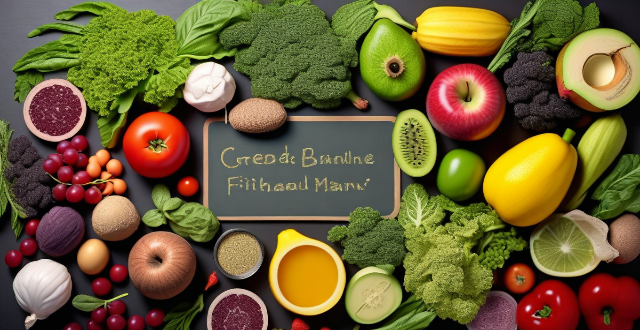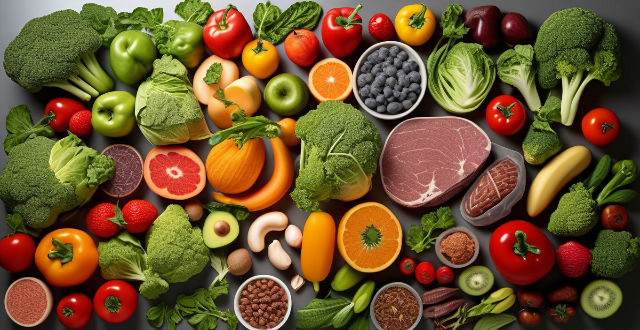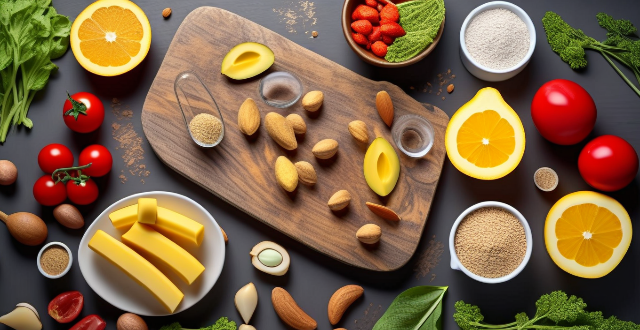Plan Meal

What are some good sources of protein for a fitness meal plan ?
Including protein-rich foods like chicken breast, salmon, eggs, Greek yogurt, and quinoa in a fitness meal plan can support muscle building and fat loss goals.

How can I create a balanced fitness meal plan ?
To create a balanced fitness meal plan, start by determining your caloric needs and focus on nutrient-dense foods. Include lean protein, whole grains, fruits, vegetables, and healthy fats in your meals. Balance your macronutrients (carbs, protein, and fats) and plan your meals and snacks ahead of time to ensure you're getting the right balance of nutrients throughout the day. Stay hydrated and be mindful of portion sizes to support your health and fitness goals.

What are the best foods to include in a fitness meal plan ?
When creating a fitness meal plan, it's important to choose foods that will help you reach your fitness goals. Here are some of the best foods to include: protein-rich foods like lean meats, fish, eggs, legumes, dairy products, and plant-based protein sources; whole grains like brown rice, quinoa, oats, whole wheat bread and pasta, barley, millet, and rye; fruits and vegetables like leafy greens, berries, stone fruits, cruciferous vegetables, and squash; healthy fats like nuts, seeds, avocado, olives and olive oil, coconut and coconut oil; and hydrating foods like cucumbers, celery, bell peppers, zucchini, tomatoes, and watermelon. Incorporating these nutrient-dense foods into your fitness meal plan will help you fuel your workouts, support muscle recovery, and achieve your fitness goals.

What are some common mistakes people make when creating a fitness meal plan ?
When creating a fitness meal plan, it's important to avoid common mistakes such as neglecting macronutrient distribution, ignoring micronutrient needs, underestimating calorie needs, overcomplicating meal preparation, and neglecting hydration. To ensure success in achieving health and fitness goals, prioritize balance, simplicity, and sustainability while focusing on meeting individual nutritional needs.

How can I make sure my fitness meal plan is sustainable long-term ?
A sustainable fitness meal plan is essential for achieving long-term health and wellness goals. To make it work, set realistic goals, plan ahead, incorporate variety, make it enjoyable, stay flexible, and seek professional advice.

What is the ideal meal plan for an athlete's daily routine ?
An athlete's meal plan should include a variety of complex carbohydrates, lean proteins, healthy fats, and fruits & vegetables to support their training goals, optimize performance, and aid in recovery. The ideal meal plan includes breakfast with sustained energy sources like whole grains and fruits; snacks such as trail mix or protein shakes to keep energy levels steady; lunch focusing on lean proteins and leafy greens for muscle repair and nutrient replenishment; afternoon snacks like Greek yogurt or fruit smoothies to avoid energy crashes; dinner emphasizing lean proteins and complex carbs for muscle recovery and glycogen replenishment; and a pre-bed snack with slow-digesting protein and natural sleep aids like cherries or chamomile tea.

How important is meal planning for maintaining a healthy diet ?
Meal planning is crucial for maintaining a healthy diet, as it allows for improved nutritional intake, time management, cost savings, and stress reduction. To implement meal planning effectively, set realistic goals, create a weekly plan, involve family members, keep it simple, and use technology to simplify the process. By following these tips, you can achieve a healthier lifestyle through effective meal planning.

How often should I be eating throughout the day on a fitness meal plan ?
When it comes to following a fitness meal plan, determining how often you should eat throughout the day can vary based on individual goals, preferences, and dietary restrictions. However, there are some general guidelines that can help you establish a balanced eating schedule. Importance of Eating Frequency: Maintain Energy Levels, Support Metabolism, Muscle Repair and Growth. General Guidelines for Eating Frequency: Three Meals a Day, Five to Six Smaller Meals, Intermittent Fasting, Snacking. Customizing Your Eating Schedule: Consider Your Goals, Listen to Your Body, Lifestyle and Routine.

What are some tips for meal prepping to promote healthy eating habits ?
Meal prepping is an excellent way to promote healthy eating habits. Here are some tips: 1. Plan your meals based on your dietary needs and preferences. 2. Create a shopping list of all the ingredients you'll need for the week. 3. Cook in bulk and choose recipes that can be easily portioned out. 4. Pay attention to portion sizes to avoid overeating. 5. Stay hydrated by carrying a reusable water bottle with you throughout the day.

How do I meal prep for a week using simple home-cooked recipes ?
Meal prepping is an excellent way to save time, money, and ensure that you are eating healthy meals throughout the week. Here's how you can meal prep for a week using simple home-cooked recipes: 1. Plan your meals based on your dietary needs, preferences, and schedule. 2. Shop for ingredients according to your meal plan. 3. Prep your ingredients ahead of time by washing, chopping, and storing them in airtight containers. 4. Cook and assemble your meals into individual portions and store them in meal prep containers. 5. Reheat and enjoy your pre-made meals throughout the week. By following these steps, you can successfully meal prep for an entire week using simple home-cooked recipes.

What are some time-saving tips for meal prep in the kitchen ?
Meal prep is an essential part of a healthy and organized lifestyle. Here are some time-saving tips for meal prep in the kitchen: 1. Plan ahead to avoid last-minute trips to the grocery store and ensure that you have everything you need for your meals. 2. Make a grocery list of all the ingredients you will need to save time by avoiding unnecessary trips to the store. 3. Choose simple recipes that require minimal preparation and cooking time, such as one-pot or pan recipes. 4. Cook in bulk to save time during meal prep by cooking large portions of food and then dividing them into individual servings for easy storage and reheating later in the week. 5. Use a slow cooker or pressure cooker to cook food while you are away from home, so you can come back to a delicious and ready-to-eat meal. 6. Prep vegetables ahead of time by washing, chopping, and storing them in airtight containers in the fridge for easy access when you need them. 7. Use frozen vegetables and fruits, which are just as nutritious as fresh ones and can save you a lot of time during meal prep. 8. Keep your kitchen clean and organized to save time during meal prep by ensuring that everything is easily accessible when you need it.

What kind of carbohydrates should I include in my fitness meal plan ?
In fitness meal planning, carbohydrates are crucial for energy during workouts and muscle recovery. Complex carbs like whole grains and legumes provide sustained energy and nutrients. Simple carbs should be limited to avoid spikes in blood sugar. Timing is key; consume complex carbs before workouts and a mix of protein and carbs afterward. Portion control is essential, with a general guideline of 45-65% daily calories from carbs. Personalized advice can be sought from a dietitian.

Can you suggest any healthy snack options for my fitness meal plan ?
The text provides a summary of healthy snack options for a fitness meal plan, including fresh fruits, nuts and seeds, Greek yogurt, vegetable sticks with hummus, and whole grain crackers with cheese. It emphasizes the importance of choosing nutritious snacks that contribute to overall fitness goals while satisfying cravings and keeping portion sizes in mind.

What is the ideal meal timing for optimal sports performance
The ideal meal timing for optimal sports performance is crucial for athletes to maximize their potential. Proper nutrition can help improve endurance, strength, and overall performance during physical activities. Key points to consider when planning meals include eating a pre-workout meal containing carbohydrates, protein, and healthy fats 2-3 hours before exercise; staying hydrated throughout the day; consuming simple carbohydrates during longer workouts; eating a post-workout meal rich in protein and carbohydrates within 30 minutes after exercising; and avoiding eating too close to workout time. By following these guidelines, athletes can ensure they have the necessary fuel for their bodies to perform at their best.

Can eating a healthy diet help with weight loss ?
Eating a healthy diet is crucial for weight loss and overall health. A balanced meal plan can increase satiety, improve nutrient intake, reduce cravings, and enhance digestion. To create a healthy meal plan, focus on whole foods, control portion sizes, choose healthy fats, stay hydrated, and plan ahead. By following these tips, you can achieve your weight loss goals while nourishing your body with essential nutrients.

How do I ensure I'm getting enough nutrients on a fitness meal plan ?
When following a fitness meal plan, it is crucial to ensure adequate nutrient intake for energy, recovery, and overall health. To achieve this, focus on whole foods, include a variety of foods from different groups, consider supplementation if needed, stay hydrated, monitor your intake, and seek professional advice when necessary.

Can you suggest some vegetarian meal prep ideas for busy weekdays ?
Vegetarian meal prep ideas for busy weekdays include roasted vegetable bowls, lentil soup, chickpea salad sandwiches, veggie burgers, and quinoa stir fry. These meals are packed with nutrients, flavorful, and convenient for busy schedules. By planning ahead and preparing these meals in advance, you can ensure that you have healthy and tasty options available throughout the week without sacrificing time or effort.

Are there any free sports and fitness apps that offer accurate calorie counting and meal planning ?
The text discusses free sports and fitness apps that offer accurate calorie counting and meal planning. It suggests four different apps: MyFitnessPal, Lose It!, Fitbit, and Nike Training Club. Each app is described in terms of its features, including calorie counting, meal planning, and exercise tracking. The text concludes by stating that these apps can help users track their progress and stay motivated towards achieving their fitness goals.

How can I reduce the amount of cleaning required after cooking a meal ?
Cleaning up after cooking can often feel like a chore, especially after spending time preparing a delicious meal. However, there are several strategies you can implement to minimize the mess and make cleaning up quicker and easier. Here's a detailed guide on how to reduce the amount of cleaning required after cooking: Before You Start Cooking - Plan Ahead: Decide what you will cook and read through the recipe completely. This helps you prepare all necessary ingredients and tools beforehand, reducing the need to clean up multiple times during cooking. Prep Your Workspace: Clear your countertops and clean them thoroughly before you start cooking. A clean work area means less mess to clean up later. Use Non-stick Cookware: Non-stick pans and bakeware require less oil or butter, making them easier to clean with just a quick wipe down. Set Up a Spill Station: Place a sheet of foil under or beside the stove to catch drips and spills, which can be easily thrown away after cooking. While You Are Cooking - Clean as You Go: Wash utensils and dishes immediately after using them. This prevents food residue from drying up and becoming harder to clean. Use Covers on Pots and Pans: This reduces splatters and saves you from having to wipe down the stove and surrounding surfaces. Contain Small Messes: Use a small bowl to hold waste like vegetable peels or fish bones rather than letting them spread over the counter. After You Have Cooked - Soak Dishes: If you have dishes that are difficult to clean, fill them with hot water and a little detergent to soak while you eat. This makes them much easier to clean later. Wipe Down Appliances: Give your appliances like blenders, mixers, or food processors a quick wipe down after use to remove any splatters. Clean the Stove Top and Countertops: Wipe these areas down with a damp cloth after cooking to avoid crusty buildup. General Tips for Efficiency - Simplify Your Recipes: Opting for simpler recipes can reduce the number of dishes used and ingredients prepared. Cook One-Pot Meals: One-pot meals like stews, casseroles, or stir-fries require fewer dishes to wash. Use Disposable Items Wisely: While not environmentally friendly, disposable items like baking paper, foil, or paper plates can be used strategically in situations where cleanup is particularly challenging.

What are the benefits of having a smoothie versus a solid meal for breakfast ?
The article discusses the benefits of having a smoothie versus a solid meal for breakfast. Smoothies are easy to digest, nutrient-dense, time-saving, and portable, while solid meals provide longer-lasting energy, more variety, better digestion, and social benefits. The choice between the two depends on individual preferences, lifestyle, and dietary needs.

Can a shopping list help me eat healthier ?
A shopping list can help individuals eat healthier by allowing them to plan meals, control ingredient choices, budget effectively, manage portion sizes, and select nutritious snack options. To create an effective shopping list, one should assess pantry and fridge contents, plan meals, prioritize whole foods, limit processed items, consider nutritional needs, and stick to the list while shopping. This approach not only promotes healthier eating habits but also supports financial management and reduces food waste.

How can I make a family dinner more budget-friendly ?
The article provides various tips for making family dinners more budget-friendly, including meal planning, buying in bulk, cooking from scratch, shopping seasonally, using leftovers creatively, avoiding impulse buys, and sharing meals with friends or family. By following these suggestions, families can save money while still enjoying tasty and nutritious home-cooked meals.

What are some easy and quick low-calorie meal prep ideas for busy weeknights ?
Easy and quick low-calorie meal prep ideas for busy weeknights include grilled chicken salad jars, zucchini noodle bowls, quinoa salad with roasted vegetables, and turkey lettuce wraps. These meals can be prepared ahead of time and stored in the fridge for easy assembly or reheating on busy nights. Planning ahead and choosing recipes that are both nutritious and satisfying is key to successful meal prep.

How can I simplify my grocery shopping process to save time in the kitchen ?
Simplifying the grocery shopping process can save time in the kitchen. Planning ahead, creating a meal plan and categorized shopping list, using technology, choosing efficient shopping strategies, and streamlining meal preparation with batch cooking and simple recipes can all contribute to a more efficient and enjoyable cooking experience.

What are the benefits of using a personalized nutrition plan from a health management app ?
Using a personalized nutrition plan from a health management app offers benefits such as improved nutritional intake, weight management, reduced risk of chronic diseases, better mental health, increased variety in diet, convenience, and accountability.

How do economists evaluate the effectiveness of a particular economic stimulus plan ?
Economists evaluate the effectiveness of economic stimulus plans by considering factors such as GDP growth rate, inflation rate, unemployment rate, job creation, government spending, deficit and debt levels, personal consumption expenditures, consumer confidence, sectoral analysis, regional impact, sustainability, and legacy. These evaluations help determine whether the plan has achieved its intended goals and guide future policy decisions.

What are the benefits of using a prepaid vs postpaid plan with a mobile operator ?
Prepaid mobile plans offer control over spending, no credit checks, easy setup and flexibility. Postpaid plans provide more features, better customer service, easier billing management and potential discounts for bundling services.

How do I ensure I'm getting enough nutrients on a vegetarian diet ?
This topic discusses the essential nutrients to watch on a vegetarian diet and provides tips for meal planning. It highlights key nutrients such as protein, iron, vitamin B12, calcium, vitamin D, and omega-3 fatty acids and suggests food sources for each. The text also emphasizes the importance of diversifying intake, considering supplementation, having regular check-ups, and working with a professional to create a balanced meal plan. Overall, it offers guidance on ensuring adequate nutrient intake while following a vegetarian diet.

How can I make my Thanksgiving meal more festive and flavorful ?
To make your Thanksgiving meal more festive and flavorful, consider planning ahead, incorporating seasonal ingredients, dressing up your table, experimenting with flavors, offering a variety of desserts, creating a cocktail bar, providing entertainment, and remembering traditions.

What is an economic stimulus plan ?
An economic stimulus plan is a government policy aimed at boosting a country's economy during times of slow growth or recession. The primary goal of such plans is to increase consumer spending, encourage business investments, and create jobs, thereby stimulating economic activity and promoting overall growth. Key features of an economic stimulus plan include tax cuts and rebates, government spending on infrastructure projects, monetary policy adjustments, direct assistance to businesses and individuals, and incentives for investment. Benefits of an economic stimulus plan include increased economic growth, job creation, long-term gains, and reduced poverty rates. However, potential downsides of an economic stimulus plan include national debt, inflation risks, crowding out effect, and short-term vs long-term effects. In conclusion, an economic stimulus plan is a multifaceted approach employed by governments to revive flagging economies. While these plans can have significant positive impacts on growth, employment, and overall well-being, they must be carefully designed and implemented to minimize potential drawbacks such as increased national debt and inflation risks.